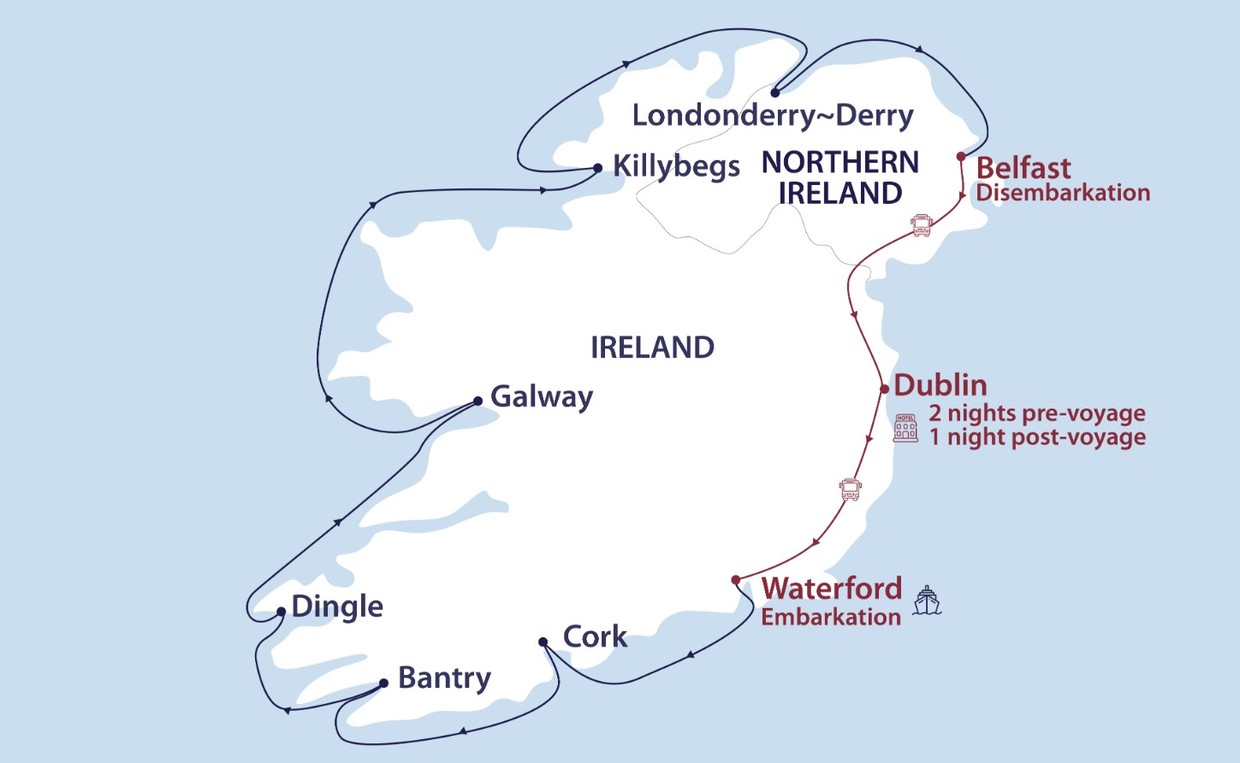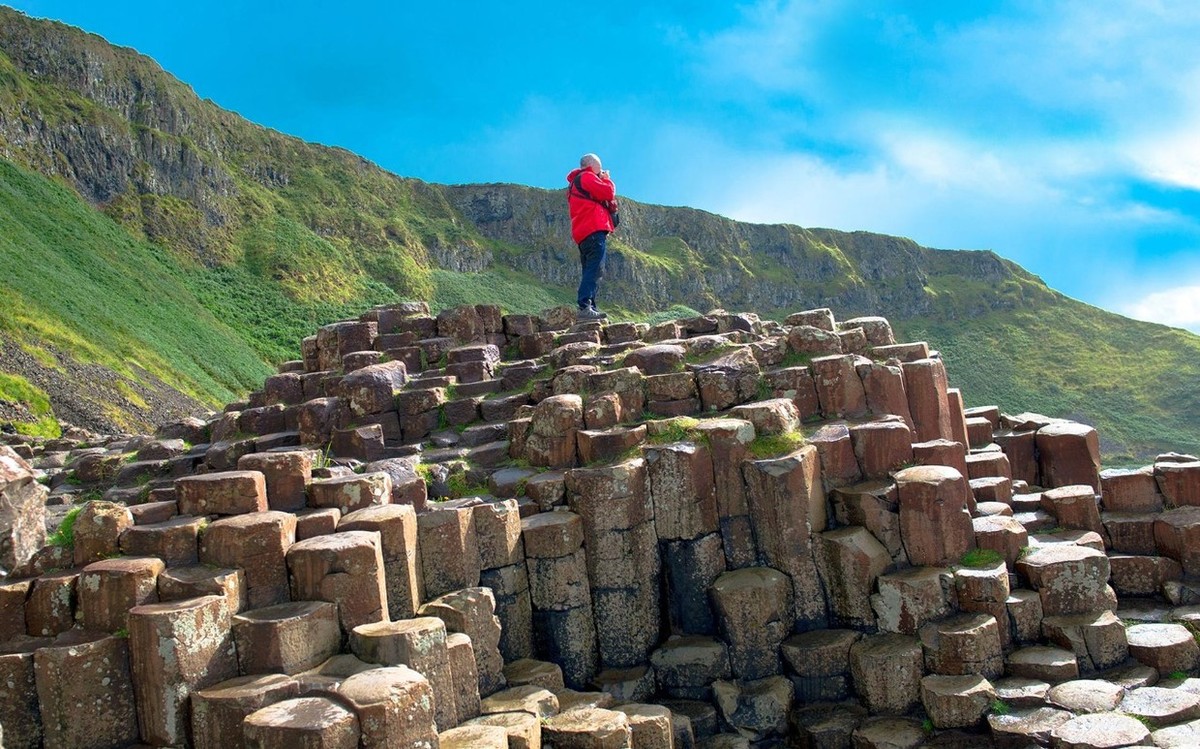
Welcome to Aurora Expeditions’ Ireland: The Luck of the Irish.
Pounded for eternity by its surrounding seas, Ireland’s coastline is best explored by ship. The country’s intimate size affords seafarers an in-depth exploration of both its coastal gems and inland treasures. We will search the cliffs, castles, backstreets and hollow tree trunks of Ireland and Northern Ireland, for stories of its saints, heroes, mythical creatures and convivial locals, as we immerse ourselves in the witty and wondrous world of Ireland’s greatest export: the Irish.
- Follow the footsteps of the Irish who left for foreign shores, at Dublin, Cobh, Kinsale and Londonderry
- Discover the rugged beauty of the Ring of Kerry, Skellig Islands, Cliffs of Moher, Slieve League Cliffs and Giant’s Causeway
- Hear tales of Ireland's past at the famine cottages, Irish workhouse, Viking Waterford, Blarney Castle,
- Belfast’s dockyards and on the streets of Dublin
- Learn about Irish ancestry with our onboard genealogist
Prices quoted here are often dependent on currency fluctuations. Please check with (01432 507450 or info@small-cruise-ships.com) for the very latest price, which may well be cheaper than the one advertised here.
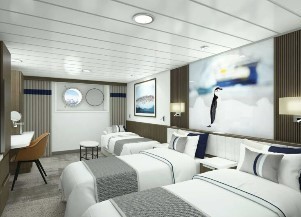
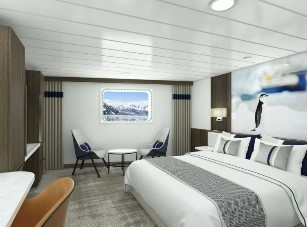
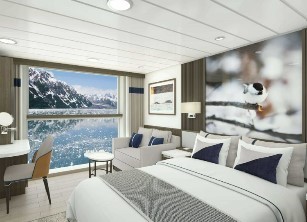
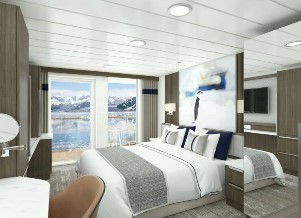
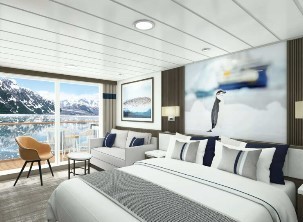
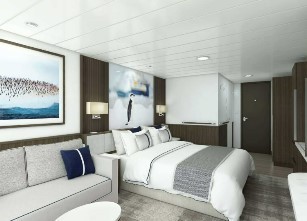
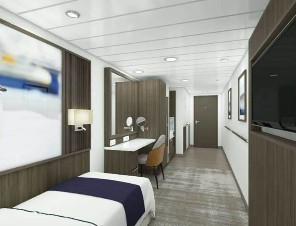
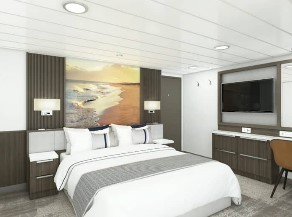
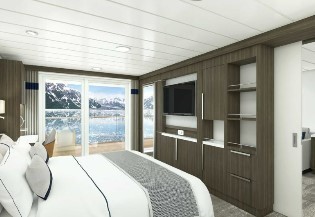
Welcome to Dublin. On arrival at Dublin airport make your way to the Arrivals Hall to meet our representative, followed by a transfer to our group hotel. At the hotel, visit our hospitality desk in the lobby to meet our team who will provide you with useful information regarding pre-embarkation procedures and about your time in Dublin. You will also receive cabin tags for your luggage. Please clearly label the tags with your name and your cabin number on the ship.
This evening offers time to relax in preparation for our ‘day out in Dublin’ tomorrow. Our group hotel has a popular restaurant and is close to plenty of corner pubs and cosy restaurants should you wish to ‘share a jar’ or try some local cuisine.
Accommodation: Dublin Hotel
Dublin, the vibrant capital of Ireland, is a city brimming with energy and resilience. Once under British rule, Dublin has emerged with a distinct sense of identity, leading Ireland as a proud member of the European Union and reflecting its evolving role in modern Europe. The city has been home to some of the world’s most influential literary figures, including Oscar Wilde, James Joyce, W.B. Yeats, and George Bernard Shaw. Iconic landmarks such as Trinity College, home to the esteemed Book of Kells, highlight its storied past, while the city also serves as a hub of artistic and cultural expression, with global musicians like U2, whose impact resonates from their Dublin roots, having invigorated its creative scene. Dublin’s vibrant pub culture offers a lively social fabric, where traditional and contemporary influences merge to create a city to explore both day and night.
Choose your favourite ‘Your Choice’ experience for a morning full of all things Irish, with time to explore Dublin this afternoon, before we gather for a Welcome Event this evening.
Personalise your exploration with our included ‘Your Choice’ experiences.
Option 1- Morning experience: Walking Dublin
Dublin’s compact character makes it an ideal one for a leisurely walking tour. This morning, our local guides entertain us with tales of the city’s character-filled history. We will hear stories of Ireland’s emotional past through the eyes of its many artists, manic Lord Mayors and rebellious citizens whilst following the park-side alleys of Dublin’s ‘backyard’, St Stephens Green, to the grand Georgian buildings of Irelands’ first university, Trinity College. Founded by Queen Elizabeth I, the grounds of the college offer 40 acres of academic seclusion from the hustle and bustle of downtown Dublin, while our path slows to hear quotes from Dublin’s most flamboyant son, Oscar Wilde, before stopping to visit the historic Huguenot cemetery and other iconic sites of Ireland’s capital, before returning to the hotel.
Option 2 – Morning experience: An EPIC Tale of Emigration
Explore one of Dublin’s top sites, focused on Ireland’s favourite topic: emigration. Our ancestry theme allows us to meet one of Ireland’s greatest exports, its people, with a self-guided tour of the award-winning EPIC – the Irish Emigration Museum. Discover what it means to hold Irish heritage, as you meet poets and presidents, singers and suffragettes. You will meet famous folk and families, from Ned Kelly to the Kennedys, as you follow your souvenir-passport to find out where they came from, why they left, and the differences they have made to our everyday lives.
Option 3 – Morning experience: The Guinness Story
The Guinness brewery opened on this spot over 250 years ago, when Arthur Guinness signed a 900-year lease – there’s only 650 years to go. We will see, hear and smell the secret ingredients as they travel through a series of vast machines, before the self-guided tour ends in the circular panoramic Gravity Bar, with its sweeping views across the city of Dublin. Here, we will enjoy a pint of ‘the black stuff’ while viewing how to pour the perfect pint at the Guinness academy. Choose to make your own way back to the hotel or catch a lift on our coach.
Accommodation: Dublin Hotel
Meals: Breakfast, Welcome Event canapés
After breakfast, we travel to Kilkenny for a visit to Kilkenny Castle en route to the Douglas Mawson.
Considered Ireland’s best preserved medieval city, Kilkenny mixes small town intimacy with a big city buzz. The former home to the seat of the medieval Irish parliaments, it rivalled Dublin in importance which is evident in its imposing Norman buildings and marble-clad facades, even today.
Few buildings in Ireland can boast a longer history of continuous occupation than Kilkenny’s monolithic castle and few have a more fascinating family story. Kilkenny Castle’s 800 years of history is associated with the rise and fall of the Marshal and Butler families who rose in nobility from Earls to Dukes. In more recent years they were known for their marriages to famous personalities like Winston Churchill’s cousin, and Ellen Stager, an American heiress who brought quite a fortune into the Butler family. However, by 1922 Kilkenny Castle was embroiled in political problems when it was occupied by Republicans and besieged by troops of the Free State. In 1967, the family sold the castle to the Kilkenny Castle Restoration Committee for a mere £50. If you love a good riches-to-rags story, you will enjoy the story of Kilkenny and its powerful peerage on a self-guided tour of the castle and its grounds.
We make our way further south to the county’s namesake, Waterford. Known as the city where culture meets the ‘craic’ (that is Irish for a good time), Waterford is a modern city with a layered history. Invaded by the Norsemen in 914, Waterford became a Viking settlement, which is reflected in its people even today. It emerged from the Middle Ages as a trading port with the wealth from goods that came from as far away as Newfoundland, the profits of which funded the construction of the many Georgian Mansions that line the city’s streets. A town for those who enjoy a good stroll, Waterford is easy on the eye, offers plenty to see and as its reputation suggests, is full of fun. Your time here is free to stroll this easily navigated city, before transferring to the Douglas Mawson.
This evening, we complete an important safety briefing, before enjoying a ‘Welcome aboard’ dinner, where we meet our crew and Aurora Expeditions team.
Meals: Breakfast, Dinner onboard
Once a port town, always a port town, Cork sits proudly on an island in the middle of the Lee River. Surrounded by water, the city’s salty air tells the story of Irish emigration, with its historical harbour of Cobh and shores of Kinsale, famed as the port of boarding for the Irish who left for foreign lands. If your ancestors are Irish, there is a high chance they came through Cork. Today, the city has a flair for great gigs and modernised traditional dishes and is considered an Irish food mecca that is centred around its restored 18th-century English Market.
Our morning shore excursions offer you the opportunity to ‘get the gift of the gab’ or follow those Irish who left their homeland for foreign shores. This afternoon, aboard the Douglas Mawson, we’ll indulge in a quintessential Irish experience with a private whiskey tasting. More than just a spirit, this ‘saintly’ brew embodies Ireland’s essence.
A local expert will share their deep passion and knowledge, guiding us through the rich heritage, meticulous craftsmanship, and captivating stories that define this amber treasure. Prepare to immerse yourself in the world of Irish whiskey and discover why it holds such a special place in the heart of Ireland.
Personalise your exploration with our included ‘Your Choice’ experiences.
Option 1- Morning experience: Cobh, the Titanic Experience & the Queenstown Story
We join a tailormade guided walking tour of Cobh, tracing the story of Irish emigration. Seeking a better life, or simply hoping to survive starvation, hundreds of thousands boarded their vessels bound for foreign lands at Cobh, formerly known as Queenstown. This included Annie Moore, a teenager who was the first immigrant to be processed at the newly opened Ellis Island in New York City. Our walking tour leads us to the Titanic Experience. On 11 April 1912, 123 passengers boarded the RMS Titanic in Queenstown (now Cobh), a bustling harbour town, bound for New York. Just days later, these individuals would face one of the most tragic maritime disasters in history. The Titanic Experience Cobh offers a poignant exploration of this fateful journey. Through knowledgeable guides and immersive audiovisual displays, visitors are transported back to that fateful April. The exhibition details the Titanic’s final days and the desperate struggle for survival after the ship struck an iceberg. Personal stories are highlighted, including those passengers who embarked from Cobh.
Having ‘survived’ the Titanic Experience we trace the story of Irish emigration, with a self-guided audio tour of ‘The Queenstown Story’ at the Cobh Heritage Centre. The ‘Queenstown Story’ traces Irish emigration since the 1600s, including the transportation of convicts to Australia and the impact of disasters like the Titanic and the Lusitania. The exhibition, housed in Cobh’s restored Victorian railway station, features personal tales, such as Jeremiah Burke’s message in a bottle from the Titanic and Margaret Drury’s convict voyage to Australia. Discover these moving stories and more, reflecting the hardships and hopes of Irish emigrants across the globe.
Option 2 – Morning experience: Blarney Castle and the Blarney Stone
If every myth, legend and limerick associated with Blarney Castle’s indomitable ‘stone’ were true, the world would be asking it to solve all our problems. Where the stone came from and how its modern-day reputation was conceived is a matter of contention, but there is no doubt that the thousands of travellers who kiss it every week receive ‘the gift of the gab’. Thought to endow all those who kiss it with eloquence and the skill of flattery, the Blarney stone is shrouded in stories. Was it a witch who was saved from drowning that revealed its power? Was it the Lord of Blarneys eloquent reply to the land title demands of Queen Elizabeth I? Was it the Goddess Cliodhna’s hinted reply to a love-lost Cormac McCarthy? Today we will find out the truth.
Option 3 – Morning experience: The Seaside Gem of Kinsale
We drive to the coast and the picture-perfect town of Kinsale, where we hear stories of naval battles, foreign invasions and shipwrecks. Once a garrison town embroiled with invading navies, Kinsale became the natural landfall for ships sailing from the continent and the Americas. It is in these waters where two of the world’s greatest ocean liners were last seen. In the early hours of 7 May 1915, the Cunard liner Lusitania was struck, only a mere 11 nautical miles off the coast of Kinsale, by a single torpedo shot from a German U-Boat. The people of Kinsale rallied to assist, but within 18 minutes she sank, with only 764 of the 1959 souls on board surviving. There is time to enjoy a stroll around this colourful coastal enclave before returning to Cork for lunch onboard.
We arrive at Bantry Bay and tender to shore. The harbourside town of Bantry is the gateway to the touring route known as the Wild Atlantic Way. It is easy to see why Ireland’s colour of choice for everything is green, from its national sporting uniforms to its flag, as we drive the famed Ring of Kerry, tread the trails of Whiddy Island or explore the Beara Peninsula, surrounded by the lush grass covered hills and dales of the Emerald Isle. For those choosing a morning excursion, Bantry itself is small enough for a comfortable stroll in the afternoon, with artisan shops, friendly cafes and, of course, plenty of pubs to try a local brew.
The wild beauty of Irelands western coast is on show today, along with the life it offered, past and present. Here we meet small town Ireland with an insight into a different side to the Irish.
This evening, we will be going ashore to meet them on an Irish night out. To be sure there will be music, singing and plenty of storytelling or this simply would not be Ireland.
Personalise your exploration with our included ‘Your Choice’ experiences.
Option 1 – Morning experience: Meet the Mayor of Whiddy Island
A 15-minute ferry crossing takes us to one of Ireland’s 80 islands – Whiddy Island, with a population of 30. A former World War I US Navy seaplane base known as Bantry Bay Station; Whiddy Island offers an insight into ‘island life in Ireland’. At just 5.5 x 1.6 kilometres in size, it is an island that is ideal for walking. It is famous for its red and purple hue provided in summer by an extensive planting of fuchsias and birdlife, as Whiddy is also home to kingfishers, little egrets and shags. But it is the story of its people that we have come to hear about, and we could not ask for a more local guide to show us around. He is the local publican, local postal worker, and he is locally known as the King of Whiddy Island. We learn about traditional baking and mussel farming and, of course, we wash it down at his pub with a local brew.
Option 2 – Morning experience: The Beara Peninsula
The Ring of Beara, located on Bantry’s neighbour, the Beara Peninsula, is one of the region’s top three scenic drives, known for its rugged and less touristy charm. This 128-kilometre route, including the renowned Beara Way, offers a journey through some of Ireland’s most striking landscapes. We encounter a dramatic coastline where the Atlantic Ocean crashes against steep cliffs, creating breathtaking views. The route is flanked by sharp-featured mountains and intricate rock formations, with exposed and contorted strata presenting a geologist’s dream. Scenic detours lead to hidden gems such as ancient stone circles, secluded beaches, and picturesque villages like Eyeries, known for its brightly painted houses. Time permitting, we visit the quaint village of Allihies, famous for its copper-mining history, offering stunning vistas of Beara’s lakes and valleys. With its wild beauty and diverse scenery, the Ring of Beara promises an unforgettable adventure for those seeking a turly authentic and rugged Irish experience.
Option 3 – Full-day experience: Ring of Kerry
No, this is not a real ring, although its presence is gold for the local economy, as a day spent driving the Ring of Kerry is the touchstone against which all other beauty spots in Ireland are measured. The Iveragh Peninsula is a magical place full of myths and legends. This landscape of sandstone hills, wooded valleys and pristine lakes has inspired poets and authors to pen many a lament. A photographer’s dream, the region is dotted with quaint towns and villages. Its lands have been carved into a series of mountain passes that whisper their story as we follow the trail of the Ring of Kerry.
It is time to join our breakfast club this morning as we sail at sunrise towards the Skellig Islands. Off the coast of County Kerry, two rocky pinnacles rise from the Atlantic Ocean. The Skellig Islands are world-renowned for their ornithological and archaeological significance. Skellig Michael is the site of a well-preserved monastic outpost of the Early Christian period and is now designated a UNESCO World Heritage Site. Little Skellig is equally renowned in matters of ornithology. As the home of 27,000 pairs of gannets, it is the second largest colony of such seabirds in the world.
Some 1,400 years ago a congregation of monks were searching for a place to practice their religion in complete solitude and isolation. Determined to build a monastery on these remote islands, generation after generation of monks hand-carved 600 stone steps with the simplest tools to build a hilltop monastery 180 metres above the pounding waves. The survival of the terraces, oratories and six corbel stone beehive huts are to this day a testament to their skill and dedication. The archaeological remains show the dramatically spartan conditions in which the monks lived; however, after enduring several Viking raids, the monks eventually left the island in the 13th century. The site has subsequently become a place of Christian pilgrimage.
Note: The Office of Public Works (OPW) manages the Skelligs, and they no longer allow cruise ship passengers to land on Skellig Michael. Visitor numbers to Skellig Michael in recent years have reached the maximum permitted by UNESCO and any violation of UNESCO criteria will affect the future UNESCO status of the island. From the elevated height of our vessel, we will enjoy a cruise of the islands before reaching Dingle Bay and tendering ashore.
Once described by National Geographic Traveller as ‘the most beautiful place on earth’, Dingle is away from the general ‘tourist route’, affording us exclusive access to the wild west coast. Traditionally a fishing port, Dingle Harbour is where we anchor and tender into town. Known for its rugged scenery, dramatic cliffs and sandy beaches, the surrounding promontory is the coastal heart of County Kerry, while Dingle itself has a bohemian flair and is famous for its hardware pubs where you can enjoy a brew and buy wares. We enjoy lunch onboard before tendering ashore to experience a slice of Ireland’s rural lifestyle, while viewing the wild side of the country and the Irish who call County Kerry home.
Personalise your exploration with our included ‘Your Choice’ experiences.
Option 1 – Afternoon experience: Dingle Peninsula and Tralee
As the Atlantic carves the coast, we watch its waves from our clifftop drive to Slea Head. Our route weaves and twists as we follow the peninsula, with stops to take in its dramatic scenery as the road narrows, and we literally drive to the edge of the ocean. An unforgiving land, this peninsula attracted medieval monks, who lived in beehive-shaped, stone clocháns, which we visit at the Fahan Beehive. On the horizon we see the deserted Blasket Islands; an unenviable place to live. The islands were evacuated in 1953 due to a dwindling, ageing population, but the islanders’ stories live on, thanks to the Blasket Centre. This interactive museum tells tales of the islanders who survived in often unliveable conditions. We hear their stories, learn some ‘real Irish’ and marvel at their tenacity, before heading onto the famed town of Tralee for a stroll of its quaint streets.
Option 2 – Afternoon experience: Life on the Land – Past and Present
We hear tales of ‘life on the land’ this afternoon as we visit ‘famine cottages’ and meet the shepherds and the sheep dogs of the Dingle Peninsula. Our scenic drive follows a route along the dramatic cliffs of the promontory, before heading inland to the farmlands of Dingle.
This land is sheep country. Generations of farmers have survived here through wild weather, outbreaks of disease and, of course, famine. The Kavanagh family is one of them. In the 19th century, the densely populated, western counties of Ireland were poverty stricken. The people in these areas were hugely dependent on the potato crop, and when the potato blight arrived in the 1840s, West Kerry experienced severe hardship. Neglected by the ruling classes, people endured horrific conditions, forcing many to emigrate, while those who remained, starved. We hear tales of extreme poverty and struggles for survival as we visit the family’s 19th-century cottages, which remain as they were during the great famine.
The story of this land continues in a lighter vein as we enjoy a sheepdog demonstration. The shepherds’ ‘best friends’ take instructions in native Irish as they show off their skills and win our hearts with their cunning ability to herd even the most determined of sheep. Off the coast we see the deserted Blasket Islands: an unenviable place to live. The islands were evacuated in 1953 due to a dwindling, ageing population, but the islanders’ stories live on, thanks to the Blasket Centre. This interactive museum tells tales of the islanders who survived in often unliveable conditions. We hear their stories, learn some ‘real Irish’ and marvel at their tenacity, before returning to the ship.
Option 3 – Afternoon experience: Dingle Bay Kayaking
The waters of Dingle Bay are popular with kayakers of all abilities. We invite all intrepid kayakers to join a local guide this afternoon to explore the coastline, sea caves and harbour of Dingle Bay. It is not unusual to encounter dolphins during this experience, but it is the geographical scenery that makes an afternoon on the bay special. You will be introduced to kayaking, before spending around 2.5 hours kayaking on the bay. We ask that you accurately assess your kayaking fitness before choosing this option, as you will not be able to leave the excursion and return to the port by yourself once the excursion has commenced. (This kayaking option requires a minimum number of participants to operate and is subject to local weather conditions. Should it be cancelled, we will try our best to provide you with another experience.)
The breakfast club meets again this morning as we sail the fabled Cliffs of Moher. Towering over the West Clare coast, the Cliffs of Moher are best seen in the early morning from the sea. Visually spectacular, they sit astride the striking landscape of the Burren on one side and the Atlantic Ocean on the other. At a height of over 200 metres at O’Brien’s Tower, and following the coast for almost 13 kilometres, these ancient cliffs were formed over 320 million years ago, and today form part of the Burren and Cliffs of Moher UNESCO Global Geopark. We enjoy a slow sail along the cliff face, before inching into Galway Bay and tendering to Galway town.
This popular west coast seaside town of Galway attracts a steady flow of local visitors. The Irish come here to walk its long promenade and as tradition dictates, kick the walls end for good luck, enjoy fish and chips straight from the newspaper and, of course, ‘go on the gargle’ in its cosy pubs.
Personalise your exploration with our included ‘Your Choice’ experiences.
Option 1 – Morning experience: Dunguaire Castle
Laundered as Ireland’s ‘most photographed castle’ Dunguaire Castle sits on a rocky outcrop on the shores of Galway Bay. Built by the dubious O’Hynes clan in the 16th century, this tower-households many secrets. Famed in song and story even to this day, Dunguaire flaunted its heyday in the 1920’s when it was bought and renovated by Oliver St John Gogarty, the famous surgeon and literary figure. Under his patronage a great Celtic revival in Irish literature encouraged literary revivalists such as W.B. Yeats, his patron Lady Gregory, George Bernard Shaw, Edward Martin, and J.M. Synge. Yeats believed strongly in the Celtic Cardic Tradition and set about reviving the ancient oral customs incorporating them into his plays and poetry. Thirty years later Dunguaire found a new owner. Originally a London fashion house socialite Christobel Lady Ampthill escaped her scandalous past when she fled to Dunguaire – a story unto itself. A visit to Dunguaire Castle offers a morning full of tales of eccentricity. On return to Galway, we enjoy a short orientation tour. Explorers wishing to stay on in Galway can experience this popular town independently, with tender shuttles to the ship available at Galway pier.
Option 2 – Full-day experience: Galway and the Workhouse Museum
We join a guided exploration of Galway upon our arrival mid-morning. Galway City is rich in culture, art, and history, and has many boutique shops offering the best of Irish crafts, literary works, and artwork. Home to two of the leading colleges in Ireland, Galway has a vibrant culture and is a town for walking. We view The Spanish Arch, that, being Irish, has no connection to Spain whatsoever, before boarding our coach for an hour or so drive through the open countryside of County Galway, where we find a testament to Ireland’s dark days.
Wracked with poverty and famines, Ireland struggled throughout the 17th – 19th centuries. Many Irish emigrated, but those who could not were often forced to enter institutions simply known as ‘The Workhouse’. As the name suggests, inmates were made to work long hours for meagre food and lodgings in terrible conditions. One of the cruellest aspects of the workhouse was that it split families, segregating them into separate living areas of women, men, girls and boys. Often family members would never see each other again. We visit a new museum, located in a former workhouse, which aims to show the plight of those who made the ultimate decision in hopes they, and their families, would survive. The museum displays artefacts that are relevant to workhouse life, some of which are the only remaining link to the people who once lived there. After our visit we return to Galway and tender to the ship.
The fishing village of Killybegs is gateway to the rugged beauty of Slieve League Cliffs and the dramatic backdrop of Ireland’s own Table Mountain, Ben Bulben. Jutting out of Sligo’s northern edge, the peninsula of Mullaghmore pokes into the North Atlantic. Land and sea meet in confluence along the coast of County Sligo, a landscape of jagged mountain peaks that inspired the work of Nobel-winning poet William Butler Yeats. We sail into the harbour of Killybegs early afternoon with time to explore the nearby cliffs and their cliffside walk or learn about sustainable whiskey distilling at the family owned and operated Adara Distillery.
Personalise your exploration with our included ‘Your Choice’ experiences.
Option 1 – Afternoon experience: Slieve League Cliffs
Slieve League is Ireland’s ultimate sea cliff experience and a signature point on the Wild Atlantic Way. Believed to be Europe’s highest accessible sea cliffs, they rise 2,000 feet from the ocean below. The lookouts here offer unspoiled views of the Atlantic as it slams the coastline of Donegal. Slieve League boasts a raw landscape and challenging lifestyle for those who call County Sligo home. We meet some of these stoic characters at the Tí Linn café and craft shop for a hot drink and scones. The Slieve League Cliffs Centre supports local artisans by selling their handmade specialties including items from the Donegal Tweed company and Triona, a company located only a few miles away at Adara.
Option 2 – Afternoon experience: Adara and the Adara Whiskey Distillery
For those who would prefer to hear about the most popular ‘spirits’ of the region, we visit the friendly folk of Adara. One of the five designated heritage towns in County Donegal, Adara has built itself a reputation as a village of craftsmen and women. The movement towards uniquely Irish goods is a growth market for the villages scattered throughout Ireland’s isolated peninsulas. It provides work for young people and whole families are typically involved in the production. As home to the popular Triona Design, visitors enjoy weaving demonstrations based on traditional methods. Steeped in tradition the Adara Distillery operations produce An Dúlamán Irish Maritime Gin and Sliabh Liag Whiskeys. Established by two ‘scatterlings’, James and Moira Doherty, who returned to the Sliabh Liag peninsula to build a legacy, the distillery employs 30 people in the village of 700. We tour the distillery to appreciate a sustainable, boutique side of Irish whiskey making. One inspired by the almost lost tradition for a smoky style of spirit, brought up to date with the best distillation know-how. We will learn about the history of Donegal’s distilling heritage and see skilled workers breathing new life into it. All tied together by a tasting of this unique brew.
Our overnight sailing takes us to Northern Ireland, and the fascinating city of Londonderry. Simply known as Derry to the Nationalist (Catholic) population but still referred to as Londonderry by the Unionist (Protestant) population, this ‘border’ town has seen it all. The sectarian ‘Troubles’ of this predominantly Nationalist city may have blemished its reputation, but in recent years these tensions have eased, and although some suburbs retain their sense of division, strolling the streets is safe and the general population are happy to share stories of their stormy past and ambitious future. We come alongside on the river Foyle, the now open, natural border between the United Kingdom and the Republic of Ireland. Choose to ‘stay in town’ to hear the city’s fascinating story, or head north to the coast to follow fables of giants and failed dynasties.
Personalise your exploration with our included ‘Your Choice’ experiences.
Option 1 – Morning experience: Londonderry~Derry – Past, Present, Future
Our local guides interpret the story of Londonderry~Derry in this excursion, which is a combination of a walking and coach tour. Having lived through the tumultuous times of ‘The Troubles’ as the locals refer to it, their first-hand experiences immerse us in the era when a word to the wrong person, a stroll on the wrong side of the street, or a misplaced glance, could cost you your life. In recent years, the artists and youth of Londonderry~Derry have painted emotive murals on walls around the city. We pass several of these as our guides explain the city’s tumultuous past. A number of monuments in the Bogside neighbourhood shed even more light on key events, such as the hunger strikes that marred the city.
Option 2 – Morning experience: The Ulster Folk Park
The Ulster American Folk Park provides a profound insight into the history of Ulster, a province in Northern Ireland with a rich cultural heritage. In the 18th and 19th centuries, over 250,000 people from Ulster emigrated to the United States and Canada. Driven by a mix of economic hardship, land shortages, and political unrest, many sought better opportunities and a new start in North America. The park vividly recreates rural Ulster life, allowing visitors to experience the conditions that prompted this mass emigration. Traditional thatched cottages, bustling village scenes, and detailed exhibits offer a glimpse into the lives left behind. Through immersive displays and historical re-enactments, the park explores the arduous transatlantic journey these emigrants endured, as well as their pioneering spirit in forging new lives. This experience provides a deep understanding of the personal and cultural transformations that defined their migration. Our one-hour drive returns us to Londonderry~Derry with time to explore the city independently this afternoon. (Please note: Due to opening hours, a boxed lunch will be supplied from the ship today, so that you may enjoy your time without interruption)
Option 3 – Full-day experience: Dunluce Castle, Giant’s Causeway
Northern Ireland is blessed with impressive natural scenery: vast valleys, glittering lakes and cliffs hoisted up from the Atlantic. We visit its most famous natural attraction, the Giant’s Causeway. Listed as a UNESCO World Heritage Site, the Giant’s Causeway consists of some 40,000 interlocking basalt columns lifted from the ocean by volcanic activity over 60 million years ago. Of course, according to legend, giants strode across columns over the sea from Scotland, creating what looks like a giant pathway of stepping-stones that start on land and disappear into the ocean. After lunch at a local restaurant, we follow the Scenic Causeway Road to Dunluce Castle. Once the headquarters of the MacDonnell clan, the castle fell victim to a violent storm and was abandoned. Its ruins and spectacular backdrop have been popular recently, after it was used as the Castle of Pyke in the famous series Game of Thrones. Returning to Londonderry~Derry, we enjoy a short driving tour before returning to the ship.
It is fair to say Belfast has endured its share of turbulent times. Famines, disease, invasions and recessions have painted a picture of a resilient city, but it was the more recent period known as ‘The Troubles’ that defined its image of division. Barbed wire, armed soldiers, and constant bomb searches kept tourists away. Today, however, Belfast has transformed, thanks to open political dialogue and foreign investment. The city feels lighter, as if a heavy burden has been lifted from its shoulders.
Our day in Belfast is filled with stories of the workers who toiled for 14 hours a day to build the world’s most glamorous ship, the Titanic, the employment it created, and the race to finish her. Had they taken their time, would things have been different for the Titanic? Located on the site where the ship was built, the dockyard’s Titanic Experience may answer a few of our questions. From the dockyards, our tour skips ahead to the days of ‘The Troubles’ as we are guided through Unionist and Nationalist neighbourhoods. The occasional security gate is a reminder that the island is still contested, but nowadays the city is split into seven virtual quarters, or cultural zones; Cathedral Quarter, Titanic Quarter, the Gaeltacht Quarter, Smithfield Market and Library Quarter, Linen Quarter, Market Quarter and Queen's Quarter. rather than walled ones. We peek at Belfast’s ‘quarters’ before turning south and returning to Dublin for our final night in Ireland’s capital.
Our evening is a farewell to our fellow explorers and a celebration of all things Irish as we kick up our heels at an authentic traditional Irish dancing show, accompanied by a few ‘jars’ and a delicious Irish Farewell dinner.
Accommodation: Dublin Hotel
Meals: Breakfast, Dinner
After breakfast, we bid farewell to all the Irish who have shared their stories with us, past and present, with a smile on our face and a story on our lips. An airport transfer shared with your fellow explorers is included for your onward flight.
Meals: Breakfast
In the spirit of 21st century travel, we encourage you to adopt a flexible and adventurous attitude when joining our voyages. This itinerary is a guide only and is subject to change due to weather, sea state, government rules, and other conditions beyond our control.
Most walks on this tour are easy to moderate, complemented by coach rides to key sights. However, many venues lack lifts due to preservation rules, and we’ll explore busy locations with narrow cobbled streets, ancient roads, and uneven steps, therefore this voyage is not suitable for passengers with walking difficulties or wheelchairs.
Douglas Mawson
Vessel Type: Small Ship Expedition
Passenger Capacity: 154
Lenght: 104.4 m
Built: 2025
Designed for global discovery
Adventure has a new name. Setting sail in 2025, our new state-of-the-art ship, the Douglas Mawson, is the last in a line of purpose-built vessels that have redefined small ship expedition cruising.
Named after the legendary Australian geologist and explorer, our new small ship embodies Mawson’s pioneering spirit and is designed for global discovery. Featuring the revolutionary Ulstein X-BOW® and purpose-built with enhanced sustainability features, it takes on average 154 adventurers to the world’s wildest places in smooth, quiet comfort. It boasts our most extensive range of cabins yet, including a range of single cabins.
The Douglas Mawson features a host of amenities to help you connect with like-minded travellers and elevate your time onboard our floating base camp for adventure. After a long day of exploring, head to the back deck to swim in the heated outdoor swimming pool, find a sun bed to read on, or soak in one of two Jacuzzis. Work up a sweat in the gym before unwinding in the sauna, resolve to learn something new in the Citizen Science Centre, then enjoy a delicious meal with new and old friends in one of two restaurants. Or, with multiple observation areas throughout the ship, simply relax in comfort while you keep watch for wildlife or incredible landscapes unfold before you.
While enjoying the luxurious amenities onboard, you can rest assured that our aim to get you off the ship to explore the natural environment as much as possible through our unique activities program remains unchanged.
Newest Ulstein X-BOW®
The Douglas Mawson features the newest streamlined Ulstein X-BOW®, designed for global discovery. The revolutionary design cuts through the swell, offering unrivalled stability on ocean crossings and helping to reduce fuel consumption. It’s just one of the many sustainability features that helps us travel more responsibly.
Heated Pool, Jacuzzis & Sauna
In between landings, enjoy access to the onboard gym or unwind in the sauna. Or head to the back deck to swim in the heated outdoor pool, enjoy a drink at the pool bar, or soak in one of two Jacuzzis, watching the world go by.
Leading Technology
The Douglas Mawson is at the cutting edge of nautical technology, fitted with industry-leading technology including world-class return-to-port equipment. The ship also features a medical clinic designed for use in remote areas.
Built for Adventure
The Douglas Mawson features Zodiac access points and an activities platform, making boarding the Zodiacs as quick, efficient and safe as possible, minimising wait times and getting you closer to the action for longer. In our mudroom you will have access to lockers to store gear & boots and rapid drying areas for clothing.
More Cabin Choices
The Douglas Mawson features 11 different types of cabins, including a range of spacious single berth cabins – all adorned with elegant Nordic interior design features.
Multiple Observation Areas
As you explore the ship you will find indoor lounge areas with floor-to ceiling windows, and multiple open decks with expansive 270-360 degree views. The Glass Atrium Lounge inside the bow is a fantastic place to sit and watch for wildlife – with a drink in hand. There is no shortage of spaces to take in the majesty of the incredible world outside!
Lecture Theatre
On all expeditions you will meet naturalists and local specialists, who offer presentations on their area of expertise to enhance your appreciation of the destination you are exploring.
Join the team in the lecture theatre for presentations covering a broad range of topics to suit every interest, from history and culture to biology and climate change. Regardless of the topic, they all have one thing in common: they all aim to engage, educate, entertain and turn you into an ambassador for the planet.
Citizen Science Center & Lounge
Learn more about the world and the unique destinations Aurora visits by visiting the onboard naturalist and Expedition Team in the world-class Citizen Science Center. You will be rewarded for your thirst for knowledge with one of the best views on the ship.
Library
With floor-to-ceiling windows, the library is a peaceful sanctuary where you can find non-fiction books to read up on the day’s destinations, use a public laptop to organise your photos or play board games with newfound friends.
Choose from our range of informative non-fiction titles, wildlife guidebooks, travel journals, novels and a selection of children’s books and board games.
Wildlife guides, books and binoculars can also be found on the observation lounge on Deck 7.
Mudroom
No need to take your wet expedition gear back to your cabin to dry. Keep your cabin warm and cosy by leaving your outer jackets and pants in the mudroom.
The mudroom is your launchpad for all shore excursions and activities. Here, you will have access to a locker when you can hang your gear up to dry, and store your boots between excursions.
Swimming Pool & Jacuzzis
There are two Jacuzzis on the top outside deck which offer amazing views of the world outside, a heated outdoor pool surrounded by sun beds you can relax on after a long day of exploring, and a pool bar.
Gym & Sauna
During your voyage, enjoy complimentary access to the gym or visit our sauna, which we highly recommend after the Polar Plunge!
Restaurants
One of the most important parts of any expedition is the food! Whatever adventures the day holds, you will be fuelled-up with hearty meals and delicious morning/afternoon teas cooked by our onboard chefs.
Meals are a great time to soak up the expedition camaraderie in our open seating dining area. Share stories with your fellow travellers and ask our expedition team questions that may have come up during the day.
Tea, coffee and snacks are available 24 hours a day, and our chefs offer different menu options and courses for each meal. Enjoy the range of house wine, beers and soft drinks included with dinner after a long day in the wild.
We also invite you to join your captain and expedition team for informal Captain’s Farewell drinks, with complimentary beverages and cocktail appetisers, followed by a 3 course meal.
Bars & Lounges
Communal meeting areas have always played a major role in fostering the warm camaraderie on board our ships. They are the heart of the expedition, where people meet to share tales from the day, swap photos, keep an eye out for wildlife and watch the sun go down.
The bars and lounges on board are refined yet inviting places to gather, with floor-to-ceiling windows offering stunning views, and of course friendly bartenders to shoot the breeze with.







